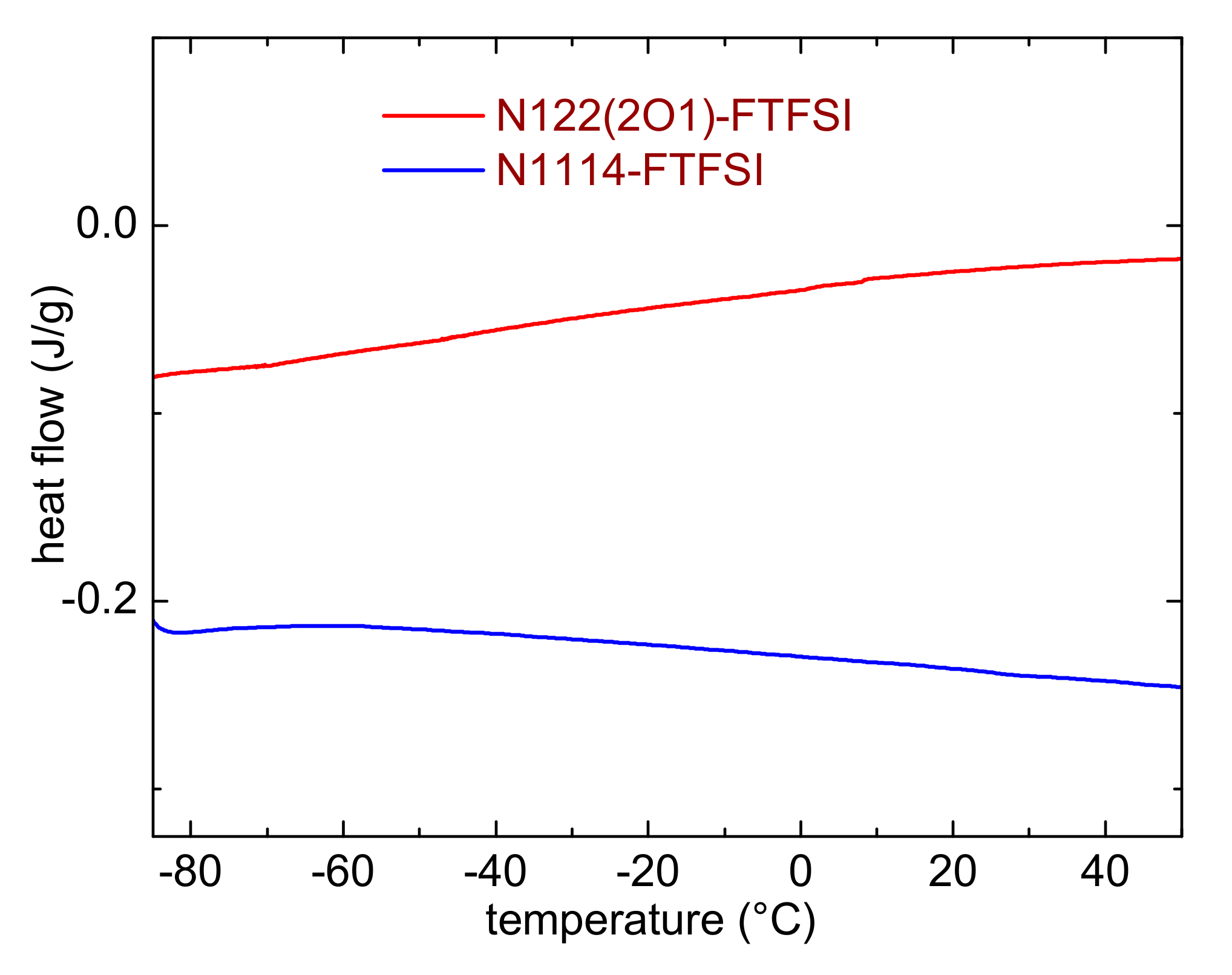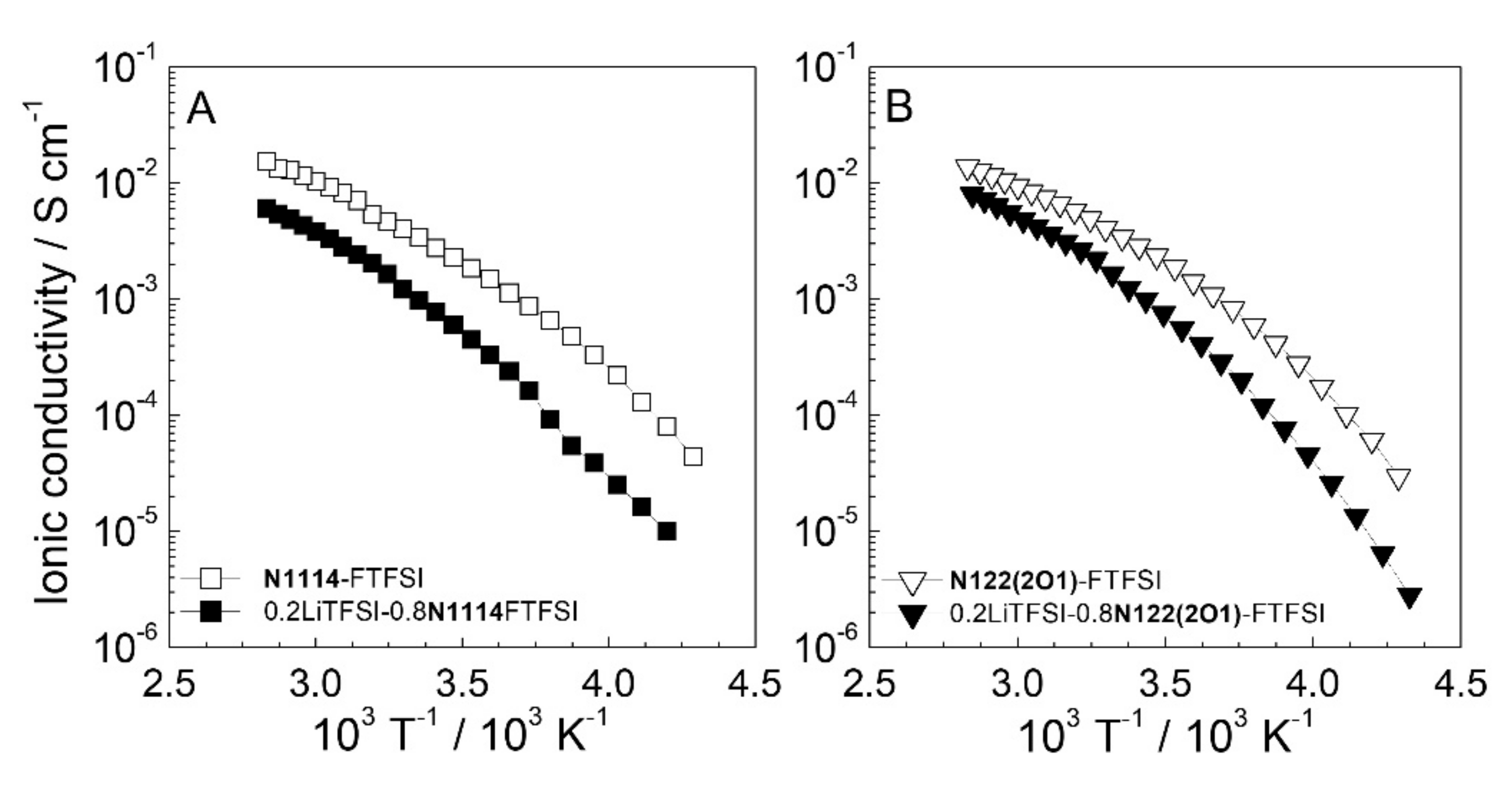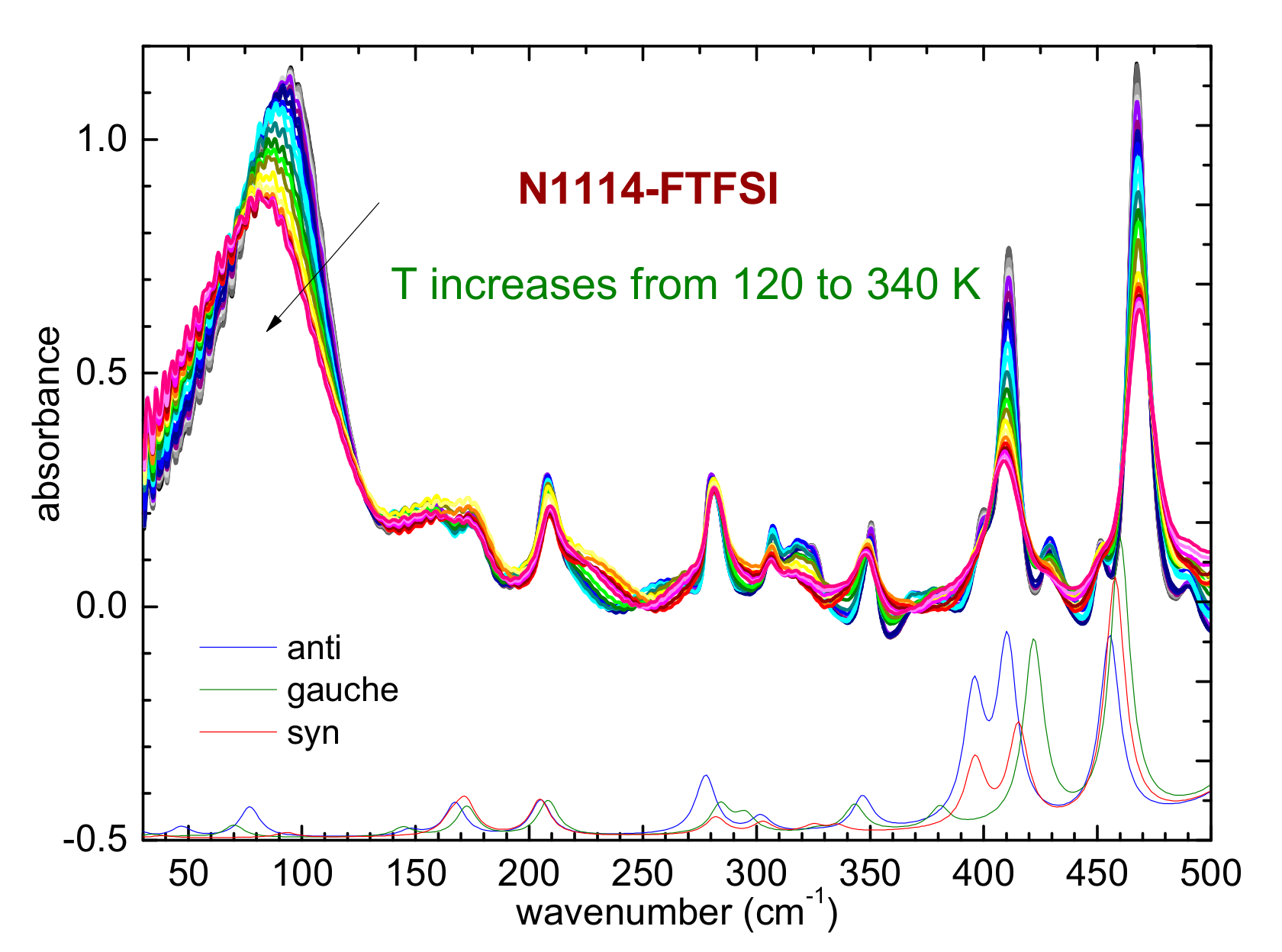Synthesis, Physical Properties and Electrochemical Applications of Two Ionic Liquids Containing the Asymmetric (Fluoromethylsulfonyl)(Trifluoromethylsulfonyl)imide Anion
Abstract
:1. Introduction
2. Materials and Methods
3. Results and Discussion
3.1. Thermal Properties
3.2. Ionic Conductivity
3.3. Electrochemical Stability
3.4. Vibrational Properties
4. Conclusions
Supplementary Materials
Author Contributions
Funding
Institutional Review Board Statement
Informed Consent Statement
Data Availability Statement
Conflicts of Interest
References
- Welton, T. Ionic liquids: A brief history. Biophys. Rev. 2018, 10, 691–706. [Google Scholar] [CrossRef] [PubMed] [Green Version]
- Pešić, J.; Watson, M.; Papović, S.; Vraneš, M. Ionic Liquids: Review of their Current and Future Industrial Applications and their Potential Environmental Impact. Recent Pat. Nanotechnol. 2021, 15, 225–244. [Google Scholar] [CrossRef] [PubMed]
- Singh, S.K.; Savoy, A.W. Ionic liquids synthesis and applications: An overview. J. Mol. Liq. 2020, 297, 112038. [Google Scholar] [CrossRef]
- Fabre, E.; Sohel Murshed, S.M. A review of the thermophysical properties and potential of ionic liquids for thermal applications. J. Mater. Chem. A 2021, 9, 15861–15879. [Google Scholar] [CrossRef]
- Tiago, G.A.O.; Matias, I.A.S.; Ribeiro, A.P.C.; Martins, L.M.D.R.S. Application of Ionic Liquids in Electrochemistry—Recent Advances. Molecules 2020, 25, 5812. [Google Scholar] [CrossRef]
- Armand, M.; Endres, F.; MacFarlane, D.R.; Ohno, H.; Scrosati, B. Ionic-liquid materials for the electrochemical challenges of the future. Nat. Mater. 2009, 8, 621–629. [Google Scholar] [CrossRef]
- Jeremias, S.; Carewska, M.; Conte, L.; Passerini, S.; Appetecchi, G.B. Asymmetry effect of novel per(fluoroalkylsulfonyl)imide anions in pyrrolidinium ionic liquids. RSC Adv. 2013, 3, 17755–17761. [Google Scholar] [CrossRef]
- Reiter, J.; Jeremias, S.; Paillard, E.; Winter, M.; Passerini, S. Fluorosulfonyl-(trifluoromethanesuldonyl)imide ionic liquids with enhanced asymmetry. Phys. Chem. Chem. Phys. 2013, 15, 2565–2571. [Google Scholar] [CrossRef]
- Meister, P.; Siozios, V.; Reiter, J.; Klamor, S.; Rothermel, S.; Fromm, O.; Meyer, H.-W.; Winter, M.; Placke, T. Dual-Ion Cells based on the Electrochemical Intercalation of Asymmetric Fluorosulfonyl-(trifluoromethanesulfonyl) imide Anions into Graphite. Electrochim. Acta 2014, 130, 625–633. [Google Scholar] [CrossRef]
- Meister, P.; Schmuelling, G.; Winter, M.; Placke, T. New insights into the uptake/release of FTFSI−anions into graphite by means of in situ powder X-ray diffraction. Electrochem. Commun. 2016, 71, 52–55. [Google Scholar] [CrossRef]
- Kühnel, R.S.; Reiter, J.; Jeong, S.; Passerini, S.; Balducci, A. Anodic stability of aluminum current collectors in an ionic liquid basedon the (fluorosulfonyl)(trifluoromethanesulfonyl)imide anion and its implication on high voltage supercapacitors. Electrochem. Commun. 2014, 38, 117–119. [Google Scholar] [CrossRef]
- Eshetu, G.; Grugeon, S.; Kim, H.; Jeong, S.; Wu, L.; Gachot, G.; Laruelle, S.; Armand, M.; Passerini, S. Comprehensive Insights into the Reactivity of Electrolytes Based on Sodium Ions. ChemSusChem 2016, 9, 462–471. [Google Scholar] [CrossRef]
- Meister, P.; Qi, X.; Kloepsch, R.; Krmer, E.; Streipert, B.; Winter, M.; Placke, T. Anodic Behavior of the Aluminum Current Collector in Imide-Based Electrolytes: Influence of Solvent, Operating Temperature, and Native Oxide-Layer Thickness. ChemSusChem 2017, 10, 804–814. [Google Scholar] [CrossRef]
- Di Lecce, D.; Sharova, V.; Jeong, S.; Moretti, A.; Passerini, S. A multiple electrolyte concept for lithium-metal batteries. Solid State Ion. 2018, 316, 66–74. [Google Scholar] [CrossRef]
- Eshetu, G.G.; Judez, X.; Li, C.; Martinez-Ibañez, M.; Gracia, I.; Bondarchuk, O.; Carrasco, J.; Rodriguez-Martinez, L.M.; Zhang, H.; Armand, M. Ultrahigh Performance All Solid-State Lithium Sulfur Batteries: Salt Anion’s Chemistry-Induced Anomalous Synergistic Effect. J. Am. Chem. Soc. 2018, 140, 9921–9933. [Google Scholar] [CrossRef]
- Ma, Q.; Fang, Z.; Liu, P.; Ma, J.; Qi, X.; Feng, F.; Nie, J.; Hu, J.-S.; Li, H.; Huang, X.; et al. Improved Cycling Stability of Lithium-Metal Anode with Concentrated Electrolytes Based on Lithium(Fluorosulfonyl)(trifluoromethanesulfonyl)imide. ChemElectroChem 2016, 3, 531–536. [Google Scholar] [CrossRef]
- Gao, X.; Wu, F.; Mariani, A.; Passerini, S. Concentrated Ionic-Liquid-Based Electrolytes for High-Voltage Lithium Batteries with Improved Performance atRoom Temperature. ChemSusChem 2019, 12, 4185–4193. [Google Scholar] [CrossRef] [Green Version]
- Chidiac, J.; Timperman, L.; Anouti, M. Small dissymmetry, yet large effects on the transport properties of electrolytes based on imide salts: Consequences on performance in Li-ion batteries. J. Energy Chem. 2022, 65, 352–366. [Google Scholar] [CrossRef]
- Chidiac, J.; Timperman, L.; Anouti, M. Physical properties and compatibility with graphite and lithium metal anodes of non-flammable deep eutectic solvent as a safe electrolyte for high temperature Li-ion batteries. Electrochim. Acta 2022, 408, 139944. [Google Scholar] [CrossRef]
- Forsyth, M.; Hilder, M.; Zhang, Y.; Chen, F.; Carre, L.; Rakov, D.A.; Armand, M.; Macfarlane, D.R.; Pozo-Gonzalo, C.; Howlett, P.C. Tuning Sodium Interfacial Chemistry with Mixed-Anion Ionic Liquid Electrolytes. ACS Appl. Mater. Interfaces 2019, 11, 43093–43106. [Google Scholar] [CrossRef]
- Umesh, B.; Chandra Rath, P.; Patra, J.; Hernandha, R.F.H.; Majumder, S.B.; Gao, X.; Bresser, D.; Passerini, S.; Lai, H.Z.; Chang, T.-L.; et al. High-Li+-fraction ether-side-chain pyrrolidinium–asymmetric imide ionic liquid electrolyte for high-energy-density Si//Ni-rich layered oxide Li-ion batteries. Chem. Eng. J. 2022, 430, 132693. [Google Scholar] [CrossRef]
- Jeong, S.-S.; Li, S.; Appetecchi, G.B.; Passerini, S. Asymmetric, quaternary, ammonium-based ionic liquids as electrolyte components for safer, high-energy lithium batteries. Energy Storage Mater. 2019, 18, 1–9. [Google Scholar] [CrossRef]
- Rigoni, A.S.; Breedon, M.; Collis, G.E.; Spencer, M.J.S. The interaction of several fluorinated ionic liquids on the LiF(001) surface. Surf. Interfaces 2021, 22, 100836. [Google Scholar] [CrossRef]
- Giffin, G.A.; Moretti, A.; Jeong, S.; Pilar, K.; Brinkkötter, M.; Greenbaum, S.G.; Schönhoff, M.; Passerini, S. Connection between Lithium Coordination and Lithium Diffusion in [Pyr12O1][FTFSI] Ionic Liquid Electrolytes. ChemSusChem 2018, 11, 1981–1989. [Google Scholar] [CrossRef] [PubMed]
- Penley, D.; Vicchio, S.P.; Getman, R.B.; Gurkan, B. Energetics of Li + Coordination with Asymmetric Anions in Ionic Liquids by Density Functional Theory. Front. Energy Res. 2021, 9, 725010. [Google Scholar] [CrossRef]
- Reber, D.; Takenaka, N.; Kühnel, R.S.; Yamada, A.; Battaglia, C. Impact of Anion Asymmetry on Local Structure and Supercooling Behavior of Water-in-Salt Electrolytes. J. Phys. Chem. Lett. 2020, 11, 4720–4725. [Google Scholar] [CrossRef] [PubMed]
- Brinkkötter, M.; Giffin, G.A.; Moretti, A.; Jeong, S.; Passerini, S.; Schönhoff, M. Relevance of ion clusters for Li transport atelevated salt concentrations in [Pyr12O1][FTFSI]ionic liquid-based electrolytes. Chem. Commun. 2018, 54, 4278–4281. [Google Scholar] [CrossRef]
- Giffin, G.A.; Laszczynski, N.; Jeong, S.; Jeremias, S.; Passerini, S. Conformations and Vibrational Assignments of the (Fluorosulfonyl)(trifluoromethanesulfonyl)imide Anion in Ionic. Liquids. J. Phys. Chem. C 2013, 117, 24206–24212. [Google Scholar] [CrossRef]
- Cimini, A.; Palumbo, O.; Simonetti, E.; De Francesco, M.; Appetecchi, G.B.; Fantini, S.; Lin, R.; Falgayrat, A.; Paolone, A. Decomposition temperatures and vapour pressures of selected ionic liquids for electrochemical applications. J. Therm. Anal. Calorim. 2020, 142, 1791–1797. [Google Scholar] [CrossRef]
- Brutti, S.; Simonetti, E.; De Francesco, M.; Sarra, A.; Paolone, A.; Palumbo, O.; Fantini, S.; Lin, R.; Falgayrat, A.; Choi, H.; et al. Ionicliquidelectrolytes for high-voltage, lithium-ionbatteries. J. Power Sources 2020, 479, 228791. [Google Scholar] [CrossRef]
- Palumbo, O.; Sarra, A.; Brubach, J.B.; Trequattrini, F.; Cimini, A.; Brutti, S.; Appetecchi, G.B.; Simonetti, E.; Maresca, G.; Fantini, S.; et al. So similar, yet so different: The case of the ionic liquids N-trimethyl-N(2-methoxyethyl) ammonium bis(trifluoromethanesulfonyl)imide and N,N-diethyl-N-methyl-N(2-methoxyethyl) ammonium bis(trifluoromethanesulfonyl)imide. Front. Phys. 2022, 10, 851279. [Google Scholar] [CrossRef]
- Montanino, M.; Alessandrini, F.; Passerini, S.; Appetecchi, G.B. Water-based synthesis of hydrophobic ionic liquids for high-energy electrochemical devices. Electrochim. Acta 2013, 96, 124–133. [Google Scholar] [CrossRef]
- De Francesco, M.; Simonetti, E.; Giorgi, G.; Appetecchi, G.B. About purification route of hydrophobic ionic liquids. Challenges 2017, 8, 11. [Google Scholar] [CrossRef] [Green Version]
- Henderson, W.A.; Passerini, S. Phase behavior of ionic liquid−LiX mixtures: Pyrrolidinium cations and TFSI-anions. Chem. Mater. 2004, 16, 2881–2885. [Google Scholar] [CrossRef]
- Appetecchi, G.B.; Montanino, M.; Zane, D.; Carewska, M.; Alessandrini, F.; Passerini, S. Effect of the alkyl group on the synthesis and the electrochemical properties of N-alkyl-N-methyl-pyrrolidinium bis(trifluromethansulfonyl)imide ionic liquids. Electrochim. Acta 2009, 54, 1325–1332. [Google Scholar] [CrossRef]
- Granovsky, A.A. Firefly Version 8.0. Available online: http://classic.chem.msu.su/gran/firefly/index.html (accessed on 7 March 2022).
- Schmidt, M.W.; Baldridge, K.K.; Boatz, J.A.; Elbert, S.T.; Gordon, M.S.; Jensen, J.H.; Koseki, S.; Matsunaga, N.; Nguyen, K.A.; Su, S.; et al. General Atomic and Molecular Electronic Structure System. Comput. Chem. 1993, 14, 1347–1363. [Google Scholar] [CrossRef]
- Al-Masri, D.; Yunis, R.; Hollenkamp, A.F.; Doherty, C.M.; Pringle, J.M. The influence of alkyl chain branching on the properties of pyrrolidinium-based ionic electrolytes. Phys. Chem. Chem. Phys. 2020, 22, 18102–18113. [Google Scholar] [CrossRef]
- Yunis, R.; Newbegin, T.W.; Hollenkamp, A.F.; Pringle, J.M. Ionic liquids and plastic crystals with a symmetrical pyrrolidinium cation. Mater. Chem. Front. 2018, 2, 1207–1214. [Google Scholar] [CrossRef]
- Appetecchi, G.B.; Montanino, M.; Passerini, S. Ionic Liquid-based Electrolytes for High-Energy Lithium Batteries. In Ionic Liquids Science and Applications; ACS Symposium Series 1117; Visser, A.E., Bridges, N.J., Rogers, R.D., Eds.; Oxford University Press Inc.: Oxford, UK; American Chemical Society: Washington, DC, USA, 2013. [Google Scholar]
- Palumbo, O.; Cimini, A.; Trequattrini, F.; Brubach, J.-B.; Roy, P.; Paolone, A. Evidence of the CH···O Hydrogen Bonding in Imidazolium-Based Ionic Liquids from Far-Infrared Spectroscopy Measurements and DFT Calculations. Int. J. Mol. Sci. 2021, 22, 6155. [Google Scholar] [CrossRef]
- Palumbo, O.; Trequattrini, F.; Cimini, A.; Tsurumaki, A.; Navarra, A.; Paolone, A. Inter- and Intramolecular Interactions in Ether-Functionalized Ionic Liquids. J. Phys. Chem. B 2021, 125, 2380–2388. [Google Scholar] [CrossRef]







Publisher’s Note: MDPI stays neutral with regard to jurisdictional claims in published maps and institutional affiliations. |
© 2022 by the authors. Licensee MDPI, Basel, Switzerland. This article is an open access article distributed under the terms and conditions of the Creative Commons Attribution (CC BY) license (https://creativecommons.org/licenses/by/4.0/).
Share and Cite
Palumbo, O.; Appetecchi, G.B.; Maresca, G.; Brubach, J.-B.; Roy, P.; Di Muzio, S.; Trequattrini, F.; Bordignon, D.; Legrand, F.; Falgayrat, A.; et al. Synthesis, Physical Properties and Electrochemical Applications of Two Ionic Liquids Containing the Asymmetric (Fluoromethylsulfonyl)(Trifluoromethylsulfonyl)imide Anion. Appl. Sci. 2022, 12, 4524. https://doi.org/10.3390/app12094524
Palumbo O, Appetecchi GB, Maresca G, Brubach J-B, Roy P, Di Muzio S, Trequattrini F, Bordignon D, Legrand F, Falgayrat A, et al. Synthesis, Physical Properties and Electrochemical Applications of Two Ionic Liquids Containing the Asymmetric (Fluoromethylsulfonyl)(Trifluoromethylsulfonyl)imide Anion. Applied Sciences. 2022; 12(9):4524. https://doi.org/10.3390/app12094524
Chicago/Turabian StylePalumbo, Oriele, Giovanni Battista Appetecchi, Giovanna Maresca, Jean-Blaise Brubach, Pascale Roy, Simone Di Muzio, Francesco Trequattrini, Delphine Bordignon, Florine Legrand, Anaïs Falgayrat, and et al. 2022. "Synthesis, Physical Properties and Electrochemical Applications of Two Ionic Liquids Containing the Asymmetric (Fluoromethylsulfonyl)(Trifluoromethylsulfonyl)imide Anion" Applied Sciences 12, no. 9: 4524. https://doi.org/10.3390/app12094524
APA StylePalumbo, O., Appetecchi, G. B., Maresca, G., Brubach, J.-B., Roy, P., Di Muzio, S., Trequattrini, F., Bordignon, D., Legrand, F., Falgayrat, A., Lin, R., Fantini, S., & Paolone, A. (2022). Synthesis, Physical Properties and Electrochemical Applications of Two Ionic Liquids Containing the Asymmetric (Fluoromethylsulfonyl)(Trifluoromethylsulfonyl)imide Anion. Applied Sciences, 12(9), 4524. https://doi.org/10.3390/app12094524








